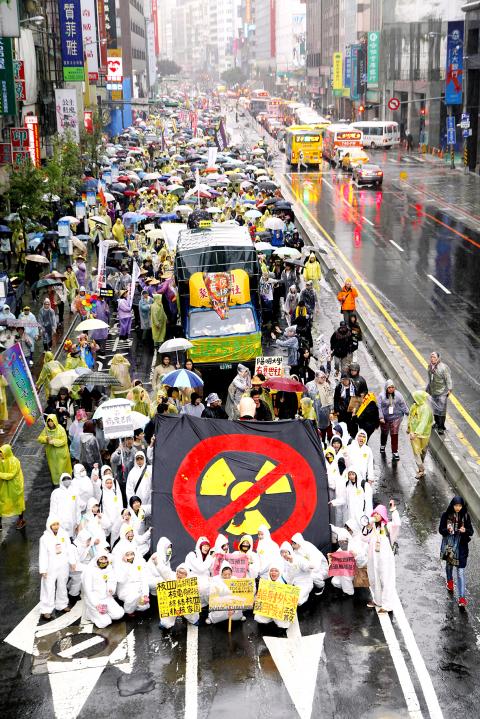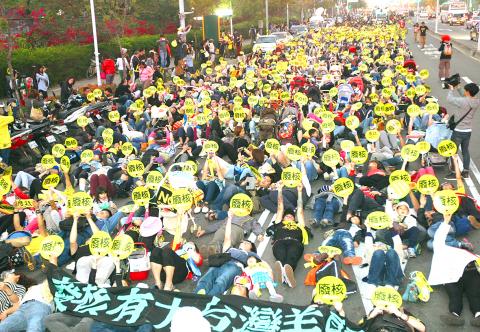Tens of thousands of people braved the rain yesterday afternoon to take part in nationwide demonstrations calling for an end to nuclear power plants in Taiwan.
The protests, staged three days ahead of the third anniversary of the Fukushima Dai-ichi nuclear disaster in Japan, took place simultaneously in Taipei, Greater Taichung, Greater Kaohsiung and Taitung.
The National Nuclear Abolition Action Platform — the event’s organizer, an alliance of more than 100 civic groups — demanded that the government immediately halt construction of the Fourth Nuclear Power Plant in New Taipei City’s Gongliao District (貢寮) and remove nuclear waste from Orchid Island (Lanyu, 蘭嶼).

Photo: EPA
The group asked lawmakers to cut the budget allocated for the new plant, pass a resolution calling for an end to nuclear power and amend the Referendum Act (公民投票法) to lower the referendum threshold.
In Taipei, a woman using a wheelchair held a handmade sign that read: “In a nuclear disaster, people in wheelchairs cannot escape,” while gender and gay rights advocacy groups held rainbow-colored signs that read: “We want orgasms, not nuclear waste” and “We may not have the same sexual preference, but we have the same anti-nuclear opinion.”
Dozens of young people danced to loud electronic dance music as they paraded while shouting: “My electro music does not want to use electricity generated by nuclear energy; my party does not fear oppressive authority.”

Photo: Huang Chih-yuan, Taipei Times
“How can I not stand up today,” said a 76-year-old fisherman surnamed Lu (盧) from New Taipei City’s Jinshan (金山), adding that he has lived in Jinshan all his life, with his home only about 5km from the plant, between two operating nuclear power plants.
“I didn’t know there were so many spent fuel rods in the plants until we had the chance to visit one of them, and I became worried, because the spent fuel pools are almost full. Will they take the fuel rods out of the water?” Lu said. “We have nowhere to run to if a disaster occurs and Taipei will be in danger.”
A highlight of the parade yesterday took place at the intersection of Zhongxiao W Road and Zhongshan S Road, where a group of residents living near nuclear facilities, young people, artists and civic groups stopped traffic by lying or sitting down on the road, as a fake nuclear accident siren sounded.

Photo: Hsu Kuo-chen, Taipei Times
The action prompted police intervention.
Green Citizens’ Action Alliance secretary-general Tsuei Su-hsin (崔愫欣) said that since the Fukushima Dai-ichi accident, annual anti-nuclear parades in Taiwan held in 2011, 2012 and last year all showed that most of the public are against nuclear power.
“The government is still stubbornly ignoring public opinion. When it wanted to push nuclear power, it said the policy was already decided and it was only acting according to the law, so people living near the facilities had no right to refuse. Now the government is using our tax money to threaten and lie to us, when it should communicate with the public and let us decide,” she said.
Tsuei said this year will be the beginning of a “citizens won’t cooperate” movement, which would make an oppressive government understand that “Taiwan doesn’t want nuclear power, the people can decide their own future.”
According to the event’s organizers, the Taipei protest drew more than 80,000 people, while other rallies held simultaneously across the country had a combined turnout of more than 50,000.
The nation has three active nuclear power plants that generate about 20 percent of its electricity.
The state-run Taiwan Power Co (Taipower, 台電) yesterday said that the Fourth Nuclear Power Plant will meet the highest safety standards before beginning operations.
Taipower vice president Chen Pu-tsan (陳布燦) said a safety review of the plant’s 126 systems is expected to be completed by the end of June, after which a report will be submitted to the Atomic Energy Council for review.
Chen stressed that passing safety inspections is just one of 75 requirements that the power plant needs to meet before fuel rods can be installed in its No. 1 reactor.
Additional reporting by AFP and CNA

The US government has signed defense cooperation agreements with Japan and the Philippines to boost the deterrence capabilities of countries in the first island chain, a report by the National Security Bureau (NSB) showed. The main countries on the first island chain include the two nations and Taiwan. The bureau is to present the report at a meeting of the legislature’s Foreign Affairs and National Defense Committee tomorrow. The US military has deployed Typhon missile systems to Japan’s Yamaguchi Prefecture and Zambales province in the Philippines during their joint military exercises. It has also installed NMESIS anti-ship systems in Japan’s Okinawa

‘WIN-WIN’: The Philippines, and central and eastern European countries are important potential drone cooperation partners, Minister of Foreign Affairs Lin Chia-lung said Minister of Foreign Affairs Lin Chia-lung (林佳龍) in an interview published yesterday confirmed that there are joint ventures between Taiwan and Poland in the drone industry. Lin made the remark in an exclusive interview with the Chinese-language Liberty Times (the Taipei Times’ sister paper). The government-backed Taiwan Excellence Drone International Business Opportunities Alliance and the Polish Chamber of Unmanned Systems on Wednesday last week signed a memorandum of understanding in Poland to develop a “non-China” supply chain for drones and work together on key technologies. Asked if Taiwan prioritized Poland among central and eastern European countries in drone collaboration, Lin

TRAGEDY STRIKES TAIPEI: The suspect died after falling off a building after he threw smoke grenades into Taipei Main Station and went on a killing spree in Zhongshan A 27-year-old suspect allegedly threw smoke grenades in Taipei Main Station and then proceeded to Zhongshan MRT Station in a random killing spree that resulted in the death of the suspect and two other civilians, and seven injured, including one in critical condition, as of press time last night. The suspect, identified as a man surnamed Chang Wen (張文), allegedly began the attack at Taipei Main Station, the Taipei Fire Department said, adding that it received a report at 5:24pm that smoke grenades had been thrown in the station. One man in his 50s was rushed to hospital after a cardiac arrest

ON ALERT: Taiwan’s partners would issue warnings if China attempted to use Interpol to target Taiwanese, and the global body has mechanisms to prevent it, an official said China has stationed two to four people specializing in Taiwan affairs at its embassies in several democratic countries to monitor and harass Taiwanese, actions that the host nations would not tolerate, National Security Bureau (NSB) Director-General Tsai Ming-yen (蔡明彥) said yesterday. Tsai made the comments at a meeting of the legislature’s Foreign Affairs and National Defense Committee, which asked him and Minister of National Defense Wellington Koo (顧立雄) to report on potential conflicts in the Taiwan Strait and military preparedness. Democratic Progressive Party (DPP) Legislator Michelle Lin (林楚茵) expressed concern that Beijing has posted personnel from China’s Taiwan Affairs Office to its